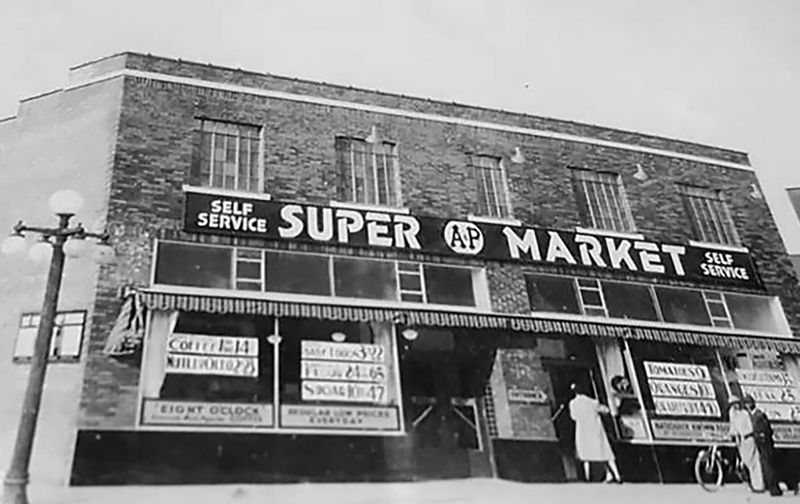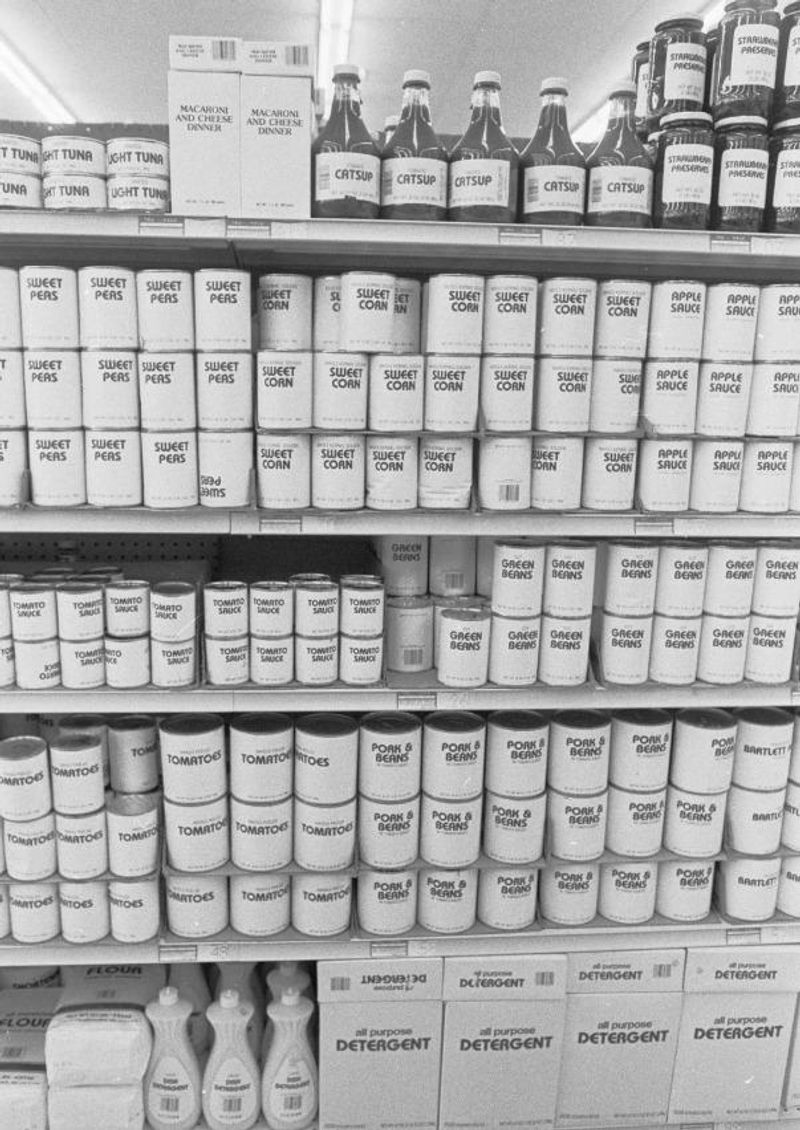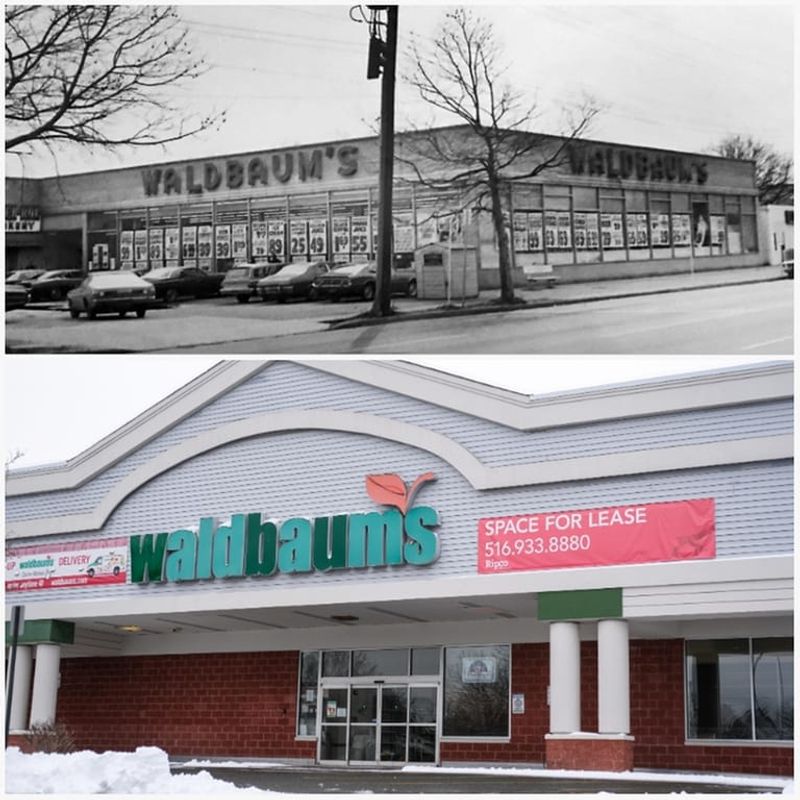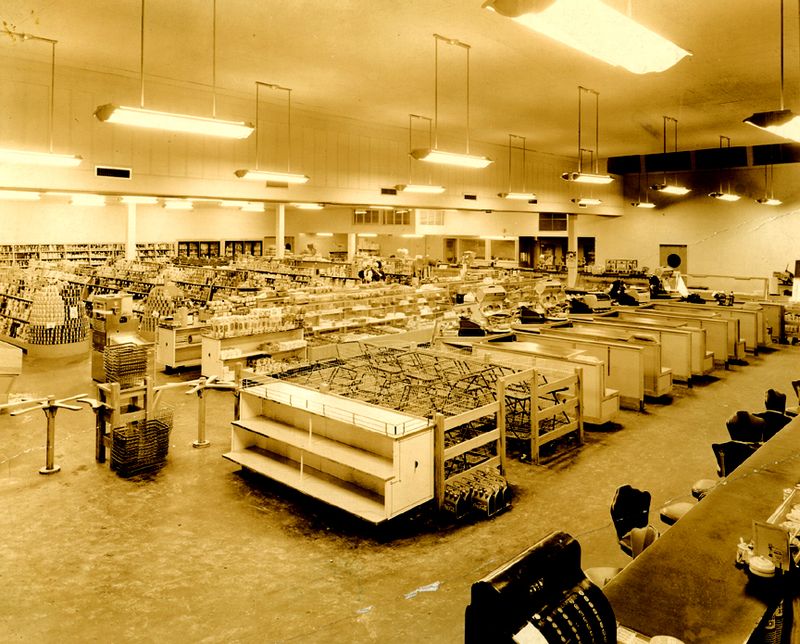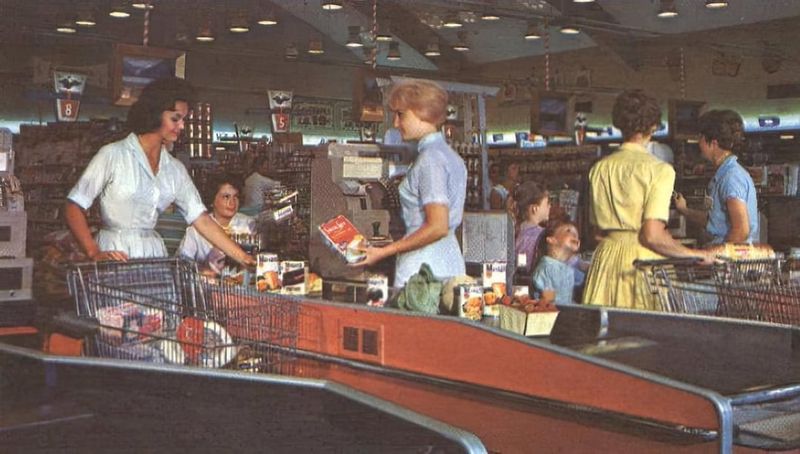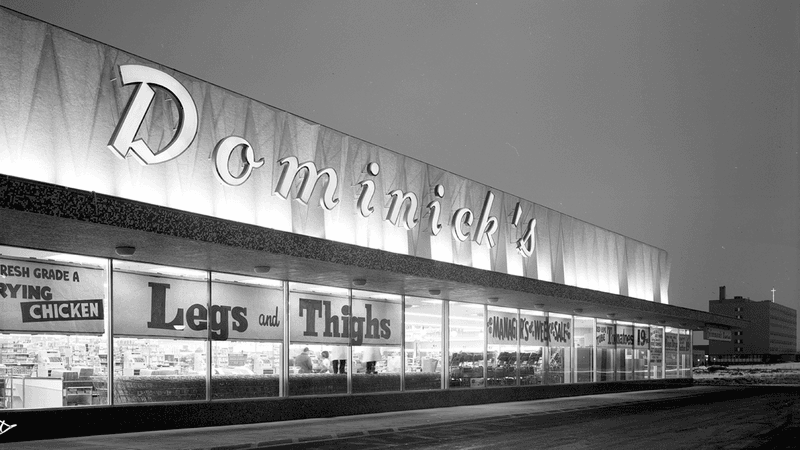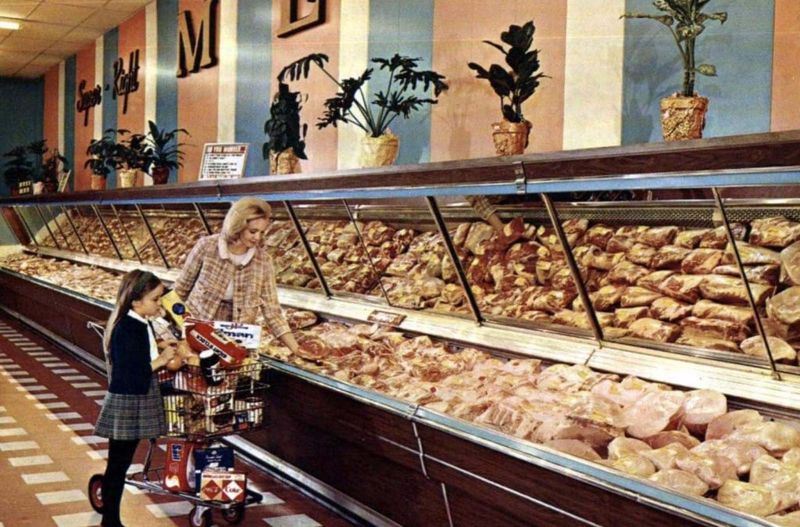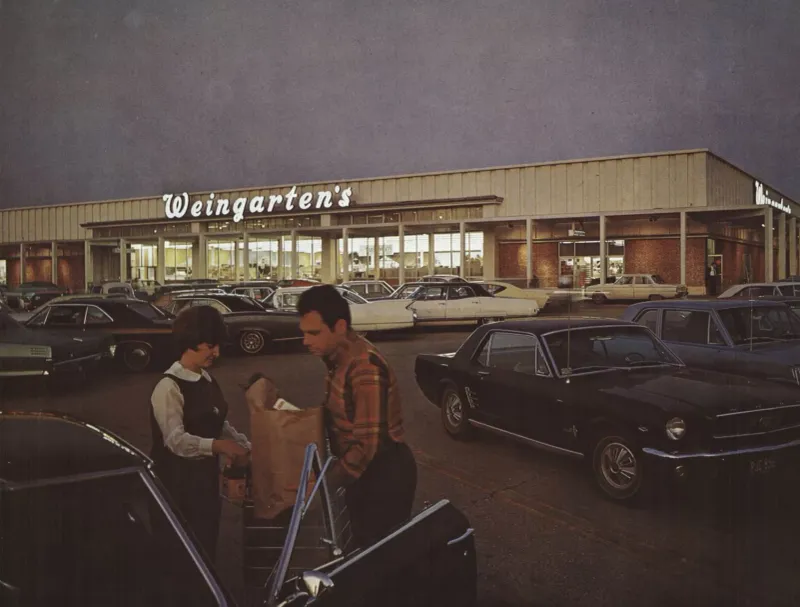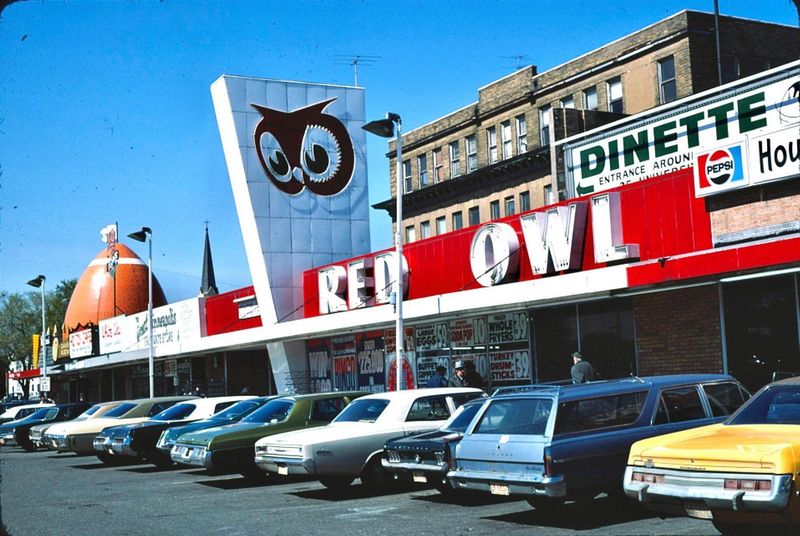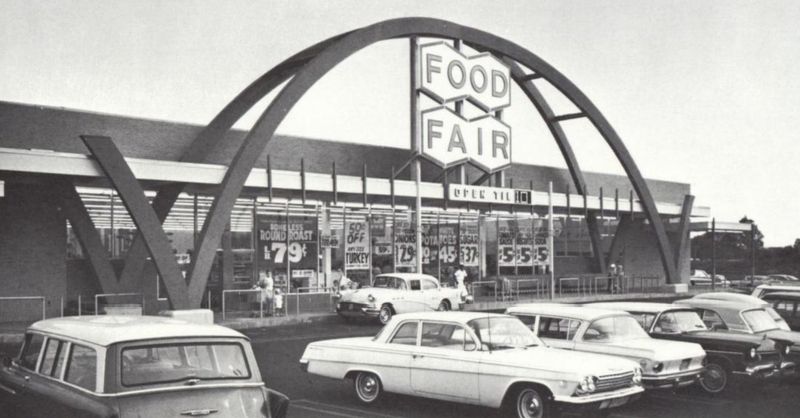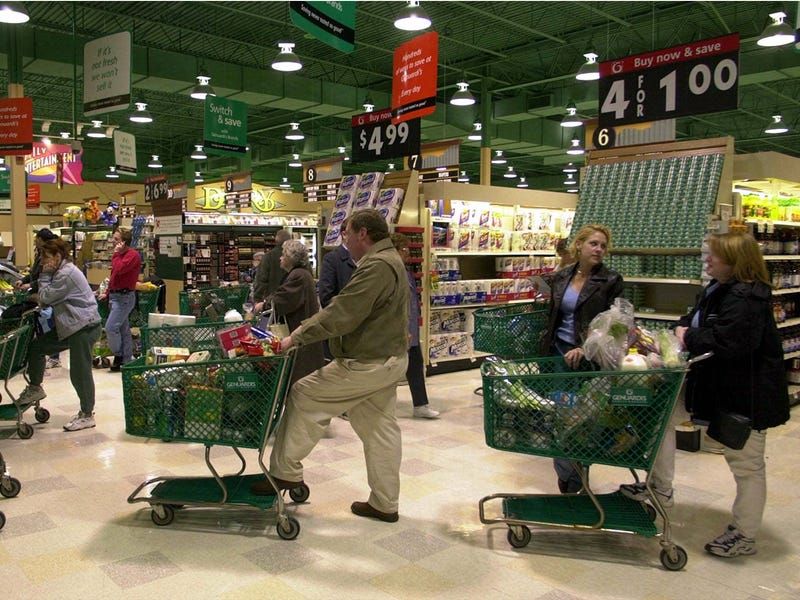Remember when grocery shopping felt like an adventure? The ’70s and ’80s were the golden age of supermarkets, with colorful packaging, distinctive store brands, and family-owned chains that became neighborhood institutions. While today’s retail landscape is dominated by mega-corporations, those bygone grocery stores hold a special place in our memories. Take a nostalgic trip down the aisles of these 15 forgotten supermarket brands that defined an era.
1. A&P: America’s Original Grocery Giant
Red and white storefronts with the iconic A&P logo once dominated American streets, making it the Walmart of its day. Founded in 1859, The Great Atlantic & Pacific Tea Company revolutionized grocery shopping with innovations like self-service stores and in-house brands like Eight O’Clock Coffee.
By the 1970s, A&P operated nearly 4,000 locations, but failed to adapt to changing consumer preferences. Their dated stores and higher prices drove shoppers away.
The once-mighty chain filed for bankruptcy in 2015, closing its final stores after 156 years in business. For many Americans, A&P represents not just a supermarket, but a vanished piece of Americana.
2. Alpha Beta: Where Groceries Lined Up Alphabetically
Shopping became a literacy lesson at Alpha Beta, the California chain that arranged products in alphabetical order. Imagine finding apple juice next to applesauce, then bread near butter – a revolutionary concept when it launched in 1917.
Kids of the ’70s fondly recall the chain’s cartoon cowboy mascot, Alphy, who appeared on store signage and in television commercials alongside Looney Tunes characters. The alphabetical gimmick eventually faded as product variety expanded beyond simple organization.
American Stores acquired the chain in 1986, converting most locations to Lucky stores. Today, not a single Alpha Beta remains, though its innovative approach to grocery organization lives on in retail history.
3. Generic Black & White Products: No-Frills Food Revolution
Before minimalist packaging became trendy, there were the stark black-and-white labeled generics of the late 1970s. These no-name products – simply labeled “BEER,” “PEANUT BUTTER,” or “POTATO CHIPS” in bold Helvetica font – sparked a retail revolution during tough economic times.
Shoppers saved up to 40% on these stripped-down versions of everyday items. No fancy marketing, no colorful designs – just the basics at rock-bottom prices.
The quality varied wildly – generic cola might taste like medicine, while canned vegetables were practically indistinguishable from name brands. Despite disappearing by the mid-’80s, these plain-wrapped products paved the way for today’s store brands at Trader Joe’s and Costco.
4. Waldbaum’s: New York’s Neighborhood Grocery Friend
Waldbaum’s wasn’t just a supermarket – it was a New York institution where generations of families filled their carts. Founded by Jewish immigrants in 1904, the chain became known for its expansive kosher sections long before mainstream markets embraced diversity.
The familiar blue-and-orange logo signaled quality and community connection. Saturday shoppers might bump into their neighbors or teachers while sampling cheese at the deli counter.
Financial troubles began after A&P purchased the chain in 1986. The beloved brand gradually disappeared from the New York landscape, with the final stores closing in 2015. Former customers still reminisce about Waldbaum’s legendary bakery department and the unmistakable aroma of fresh-baked challah on Friday afternoons.
5. Bohack’s: The Big Apple’s Beloved Corner Market
Long before Whole Foods arrived, Bohack’s reigned supreme on New York City street corners. Founded by Czech immigrant Henry Bohack in 1887, this grocery chain grew to over 500 locations across the metropolitan area by the 1970s.
Locals raved about “Bohack’s Best” house brands and the legendary in-store cheesecake that rivaled famous bakeries. The stores were smaller than today’s supermarkets but packed with personality – wooden floors creaked underfoot while butchers knew customers by name.
Rising competition and a crippling 1974 warehouse strike ultimately doomed the company. Bohack’s filed for bankruptcy in 1977, closing a 90-year chapter in New York’s retail history and leaving behind only faded signs on old buildings.
6. Jitney Jungle: Southern Shopping with Small-Town Charm
The quirky name “Jitney Jungle” originated from Depression-era slang – “jitney” meant a nickel, suggesting affordable prices. This Mississippi-born chain became a Southern institution, expanding across six states with nearly 200 stores during its 1970s heyday.
Walking into Jitney Jungle meant experiencing true Southern hospitality. Employees knew customers’ names, and the stores featured sit-down cafes serving comfort food like fried chicken and buttermilk pie.
The chain pioneered one-stop shopping by adding pharmacies and garden centers decades before Walmart made it standard practice. After Winn-Dixie acquired the company in 2000, the distinctive name disappeared. Former shoppers still reminisce about the store’s friendly atmosphere and legendary house-made pimento cheese.
7. Eagle Food Centers: Midwest’s Soaring Supermarket Success
Eagle Food Centers spread their wings across Illinois, Iowa and Wisconsin, becoming a Midwestern shopping landmark with their distinctive orange-and-brown color scheme. Founded in 1893 as Eagle Discount Supermarkets, the chain pioneered self-service shopping when most grocers still retrieved items for customers.
Kids of the ’70s fondly remember Eagle’s in-store bakery cookies given free to children and the excitement of S&H Green Stamps with every purchase. The company’s mascot – a cartoon eagle wearing a grocer’s apron – adorned weekly newspaper circulars.
Unable to compete with Walmart’s expansion, Eagle declared bankruptcy in 2000. The final stores closed in 2003, ending 110 years of Midwest grocery history and leaving only memories of their famous “Eagle Value” private label products.
8. Dominick’s Finer Foods: Chicago’s Hometown Grocery Hero
For Chicagoans, Dominick’s wasn’t just a grocery store – it was part of the city’s identity. Founded by Italian immigrant Dominick DiMatteo in 1918 as a small deli, it blossomed into a powerhouse chain with nearly 100 locations across the Windy City by the 1980s.
The stores were known for exceptional produce hand-selected by staff and innovative features like in-store video rental departments. Their slogan – “Fresh Store, Fresh Ideas” – wasn’t just marketing; it was a philosophy.
Safeway’s 1998 acquisition marked the beginning of the end. Corporate standardization erased the local character that made Dominick’s special. The final locations closed on December 28, 2013, leaving Chicagoans mourning their hometown grocery hero.
9. The Boys: California’s Produce Paradise
Before fancy farmers markets became trendy, The Boys Markets brought farm-fresh produce to Southern California neighborhoods. Starting as a simple fruit stand in 1923, this family-run chain grew to 50 locations known for quality produce at bargain prices.
Shopping at The Boys felt like visiting a bustling Italian market. Employees shouted specials across aisles while mountains of colorful fruits and vegetables dominated the entrance. Their radio jingle – “The Boys, The Boys, where the neighborhood shops!” – became an earworm for local kids.
Yucaipa Companies acquired the chain in 1994, converting most locations to Ralphs or Food 4 Less. Though the name has vanished, The Boys pioneered the emphasis on fresh produce that upscale grocers now emulate.
10. Grand Union: Northeast’s Premier Shopping Destination
With a name suggesting railroad heritage, Grand Union chugged through Northeastern communities for over 125 years. The red-and-white logo became synonymous with grocery shopping from Vermont to Virginia, with over 700 stores at its peak.
During the ’70s, Grand Union introduced innovations like in-store bakeries and expanded international food sections. Their sprawling stores featured wide aisles and bright lighting – modern marvels compared to cramped corner grocers.
Financial troubles derailed the company in the 1990s. After multiple bankruptcies, the Grand Union name disappeared in 2001, briefly revived in 2012, then vanished again. Former shoppers still talk about their distinctive green shopping carts and the excitement of double coupon days that drew crowds every Wednesday.
11. Hinky Dinky: Nebraska’s Whimsically Named Wonder
With a name straight from a children’s rhyme, Hinky Dinky brought smiles to Midwestern shoppers for nearly 80 years. Founded in Omaha in 1925, this quirky chain expanded throughout Nebraska and Iowa, becoming known for both its unusual name and forward-thinking practices.
The company pioneered automated checkout systems in the early 1970s – revolutionary technology at the time. Their cartoon mascot – a winking grocer named “Hinky” – appeared on everything from store signs to private label products.
Corporate consolidation led to Hinky Dinky’s gradual disappearance in the 1980s. Though the stores are gone, the catchy name lives on in regional expressions. Older Nebraskans still describe quick shopping trips as “running to the Hinky Dinky” regardless of where they actually shop.
12. Weingarten’s: Texas Grocery Pioneer
Long before Whole Foods emerged from Austin, Weingarten’s defined grocery shopping across the Lone Star State. Founded by Jewish immigrants in 1901, this Houston-based chain expanded to over 100 locations by the 1970s, becoming Texas’ premier supermarket destination.
The stores were architectural showcases featuring distinctive arched roofs and massive parking lots – innovations for their time. Weingarten’s introduced Texans to self-service shopping and expanded frozen food selections when most still shopped at butchers and produce stands separately.
Grand Union purchased the chain in 1980, converting most locations to other brands. The final Weingarten’s closed in 1984, but the company’s real estate division continues operating today. Many former store buildings remain standing, repurposed as everything from fitness centers to dollar stores.
13. Red Owl: Midwest’s Watchful Grocery Guardian
The wise-looking owl logo watched over Midwestern grocery aisles for decades, making Red Owl a beloved regional institution. Founded in Minnesota in 1922, the chain spread its wings across Wisconsin, Michigan, and the Dakotas, peaking at 441 stores during the 1970s.
Red Owl built its reputation on exceptional meat departments, proudly calling themselves “The Meat People” in advertisements. Their distinctive brown paper bags with the red owl logo became shopping staples for generations of families.
The company’s innovative franchise model allowed small-town grocers to compete with larger chains. SuperValu purchased Red Owl in 1988, gradually converting or closing locations. Though the last store closed in the early 2000s, collectors now pay premium prices for vintage Red Owl advertising items and memorabilia.
14. Food Fair/Pantry Pride: East Coast Grocery Evolution
Food Fair wrote the book on grocery evolution, transforming from small Philadelphia meat market to major chain before reinventing itself as Pantry Pride in the 1970s. At its peak, over 500 locations dotted the Eastern Seaboard, known for bright yellow storefronts and the catchy “Food Fair is pantry proud!” jingle.
The chain pioneered trading stamps – S&H Green Stamps came with every purchase, redeemable for household goods. Entire families would gather around kitchen tables, licking stamps into collection books.
Financial troubles forced the company into bankruptcy in 1978. Though the stores disappeared by the mid-1980s, the Pantry Pride name lived on through a corporate shell that became notorious for hostile takeovers, including the controversial acquisition of cosmetics giant Revlon.
15. Genuardi’s: Philadelphia’s Family Grocery Tradition
Shopping at Genuardi’s meant joining an extended Italian family. Founded in 1920 by Gaspare Genuardi, who sold produce from a horse-drawn cart, the chain maintained its family-run charm even as it grew to 38 stores across the Philadelphia region.
The stores were known for homemade Italian specialties – their signature tomato sauce recipe remained unchanged for decades. Unlike corporate competitors, Genuardi’s maintained personal touches like carryout service and handwritten signs.
Safeway’s 2001 acquisition marked the beginning of a slow decline. Loyal customers complained about diminished quality and corporate standardization. The final Genuardi’s closed in 2015, ending nearly a century of family grocery tradition that began with a simple horse and cart.

